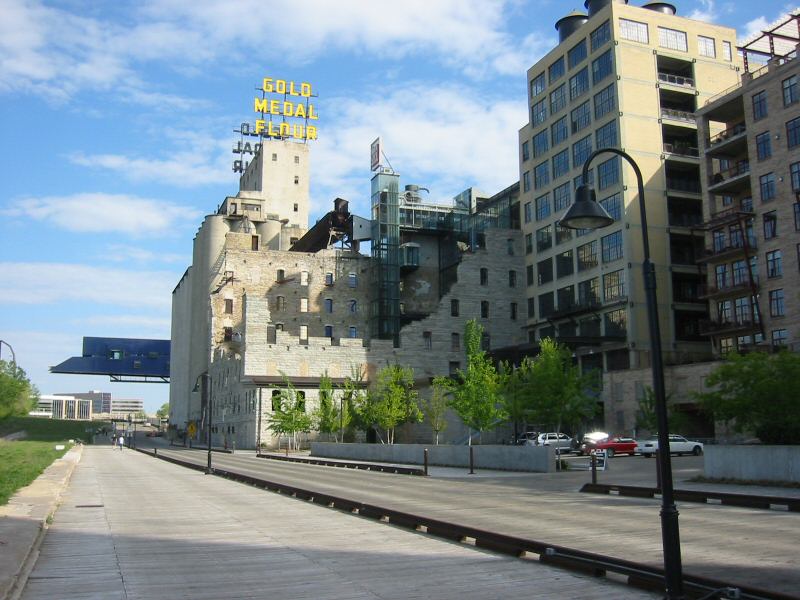- Washburn "A" Mill
Infobox_nrhp | name =Washburn A Mill Complex
nrhp_type =nhl

caption =The Washburn "A" Mill complex inMinneapolis, Minnesota . The blue structure jutting out beyond the grain elevators is the skybridge from the newGuthrie Theater . The two buildings on the right are historic buildings that have been retrofitted for residential use.
location= 1st St., S. at Portland Ave.Minneapolis, MN
lat_degrees =44 | lat_minutes =58 | lat_seconds =44 | lat_direction = N
long_degrees =93 | long_minutes =15 | long_seconds = 25 | long_direction = W
area =
built =1879
designated =May 04 ,1983 cite web|url=http://tps.cr.nps.gov/nhl/detail.cfm?ResourceId=1868&ResourceType=Building
title=Washburn A Mill Complex |accessdate=2007-11-06|work=National Historic Landmark summary listing|publisher=National Park Service]
added =May 04 ,1983 cite web|url=http://www.nr.nps.gov/|title=National Register Information System|date=2006-03-15|work=National Register of Historic Places|publisher=National Park Service]
governing_body =Minnesota Historical Society
refnum=83004388The Washburn "A" Mill was the second-largest
flour mill inMinneapolis, Minnesota . The original mill was built in 1874 byCadwallader C. Washburn , but destroyed in an explosion in 1878, killing 18.The mill was later rebuilt, and for nearly 50 years, the Washburn "A" Mill was the most technologically advanced and the largest mill in the world. It was later shut down but now operates as a historical museum of the local milling industry. It is now called the Mill City Museum.
Just in front of the complex is the
Mill Ruins Park .The Washburn "A" Mill and Mill Ruins Park are part of the
St. Anthony Falls Historic District and within theNational Park Service 'sMississippi National River and Recreation Area .History
At the peak of its production, it could grind enough flour to make 12 million loaves of bread per day. An ad from the 1870s advertised, "Forty-one Runs of Stone. Capacity, 1,200 Barrels per Day. This is the largest and most complete Mill in the United States, and has not its equal in quantity and quality of machinery for making high and uniform grades of Family Flour in this country." Advertising hyperbole aside, the mill, along with the
Pillsbury "A" Mill and other flour mills powered bySt. Anthony Falls , contributed greatly to the development of Minneapolis.citation|title=PDFlink| [http://pdfhost.focus.nps.gov/docs/NHLS/Text/83004388.pdf National Register of Historic Places Inventory-Nomination: Washburn A Mill Complex] |1.11 MiB |author=George R. Adams and James B. Gardner|date=September 1978 |publisher=National Park Service and PDFlink| [http://pdfhost.focus.nps.gov/docs/NHLS/Photos/83004388.pdf Accompanying 7 images, including photos from 1978.] |692 KiB ]On
May 2 ,1878 , a spark ignited airborne flour dust within the mill, creating an explosion that demolished the seven story Washburn A Mill. The explosion destroyed two other nearby mills and an ensuing fire decimated the surrounding business district. Fourteen Washburn workers perished, as well as four workers in neighboring buildings. Known as the Great Mill Disaster, the explosion made national news and served as a focal point that led to reforms in the milling industry. In order to prevent the buildup of combustible flour dust, ventilation systems and other precautionary devices were installed in mills throughout the country.By 1880, Washburn had rebuilt the “A” mill as the largest flour mill in the world until the
Pillsbury "A" Mill was built across the river the following year. Washburn later teamed up with John Crosby to form the Washburn-Crosby Company, which later becameGeneral Mills . [cite web |url= http://www.mpls.lib.mn.us/history/eh5.asp |title= Falls of St. Anthony |accessdate = 2007-08-02 |work= A History of Minneapolis |publisher= Minnesota Public Library]After
World War I , flour production in Minneapolis began to decline as flour milling technology no longer depended on water power. Other cities, such asBuffalo, New York became more prominent in the milling industry. Later on in the mill's lifetime, General Mills started putting more emphasis on producing cereals and baking mixes and shifted away from flour milling. Also, since the Washburn "A" Mill was only equipped to produce white flour, it was unable to cope with the increase in demand of whole-wheat flour and other products. The mill was shut down in 1965, along with eight other of the oldest mills operated by General Mills, and left in disuse. In 1991, a fire nearly destroyed the old mill, but during the late 1990s, the city of Minneapolis, through the Minneapolis Community Development Agency, worked to stabilize the mill ruins.Mill City Museum
The
Minnesota Historical Society now operates the Mill City Museum within the structure. The museum features exhibits of the history of milling, examples of the machinery that was used to grind wheat into flour, and a tour that shows the jobs that were performed on each of the eight floors of the mill. In the centerpiece display of the museum, visitors are seated in a large elevator in the "Flour Tower", where they are taken, floor by floor, to an animatronic recreation of the machinery that used to be on every floor of the mill. At the end of the tour, visitors are taken to an outdoor observation area at the top of the mill structure, where they can overlook the old complex as well as have spectacular views of the riverfront area.At the top of the adjoining grain elevator, the "Gold Medal Flour" sign still shines at night. Across the river, the former competitor
Pillsbury "A" Mill is topped with a sign reading "Pillsbury's Best Flour."References
*cite web|url=http://www.millcitymuseum.org/|title=Mill City Museum|publisher=Minnesota Historical Society|accessdate=2006-05-13
* cite book
last = Hofsommer
first = Don L.
authorlink =
coauthors =
year = 2005
title = Minneapolis and the Age of Railways
publisher = University of Minnesota Press
location = Minneapolis, MN
isbn = 0-8166-4501-9External links
Wikimedia Foundation. 2010.
